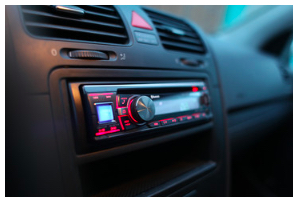Car Audio Basics
 Car Audio can get pretty tweaks, but there are only three main components at its core. The head unit provides an audio signal, the amplifier boosts it, and the speakers produce the sound. Ensure the system can produce high-fidelity tunes at low, medium, and loud volumes. Test a system by playing Tidal or lossless FLAC files.
Car Audio can get pretty tweaks, but there are only three main components at its core. The head unit provides an audio signal, the amplifier boosts it, and the speakers produce the sound. Ensure the system can produce high-fidelity tunes at low, medium, and loud volumes. Test a system by playing Tidal or lossless FLAC files.
The head unit (or receiver) is the heart of your car audio system. It controls everything else, from the simple radio to the advanced multimedia systems found in some vehicles. It’s where music is played, and it sends signals to the amplifier to help create sound. It can play multiple media formats, including AM and FM radio, CDs and DVDs, USB flash drives, dashcams, satellite radio, Bluetooth, and hands-free phone calls.
The first component in a stereo is the amplifier, which increases the strength of the head unit’s signal. Without it, the audio signal would be too weak to drive speakers and create sound. Some basic car audio systems have a head unit with no amp, but even they need an amplifier to get the most out of their speakers.
Speakers are the final piece of the puzzle, and they are responsible for actually producing sound. They convert the electrical signal sent by the amplifier into physical movement – the vibrating cones of the speakers displace air to create sound waves that you can hear. They vary in quality and form factor, and there are many viable options to choose from for any vehicle.
If you’re thinking of replacing your factory head unit, don’t settle for an outdated or mediocre model. Modern Android head units will make your vehicle feel more futuristic, with voice commands and navigation assistance, along with a variety of other exciting features. They are available in Single-DIN and Double-DIN configurations.
When installing a new head unit, be careful not to pull on the wires too hard. This could damage the plastic plugs and shear off the locking tabs that hold the wire in place. It’s better to let a professional do the work, and they can use a wiring harness that plugs into your vehicle’s factory wiring.
If you have a pair of decent speakers and an aftermarket amp, the only thing keeping them from performing at their best is a low-quality signal. If you want to improve your sound quality and really make your ride feel like a mini-theater, talk to an expert about upgrading your audio components.
Amplifier
Car stereo amplifiers play a major role in the sound quality of your car audio system. They boost the low-level audio signal from the head unit so it can drive the speakers to produce sound. An underpowered amp can lead to distortion and muffled, flat sounds. A high-quality amp can bring out the details and fullness of the music you listen to, no matter the volume level.
An in-car audio system can incorporate any number of components – including FM radio, CD players and USB flash drives. Some are designed to work with mobile phones via Bluetooth connectivity. Other systems may include a DVD player and navigation functionality. Depending on the brand, in-car audio can also include premium features such as active noise cancellation or voice command activation.
Amplifiers can be a great upgrade to any car stereo system. Adding an aftermarket amplifier can increase the overall output power of your speakers, as well as bring out the detail and clarity of the audio signal. The best amplifiers offer multiple RCA inputs to easily connect to existing factory head units and allow you to add more amplifier channels in the future, if necessary. Many amplifiers also feature a pass-through output that allows you to use the factory speaker wires, rather than running another set of RCA cables. You’ll want to look for an amplifier that has a ‘power wire gauge’ rating, which indicates the size of the power terminal it accepts.
Most factory audio systems feature underpowered amps that can limit how loud your music plays. Upgrading to a higher-powered car audio amplifier will improve the overall sound quality of your stereo system, allowing you to crank up the tunes without losing any clarity or impact.
Adding more speakers will increase the overall output power of your system, but you’ll need to choose speakers that can handle this added demand. You’ll also want to consider each speaker’s RMS wattage (as opposed to its peak wattage) to ensure they can deliver the maximum power required for each channel on your amplifier.
For the best results, it’s recommended that you test your new audio system with a wide variety of music. This will allow you to get a feel for how your system sounds at low, medium and high volumes.
Speakers
Car speakers convert electrical current into sound waves. To produce a given amount of sound, the speakers require a certain amount of power, which is measured in watts (RMS). Speakers that can safely handle more power will have higher sensitivity ratings than those that cannot. Another important factor is the speakers’ impedance, which is a measure of how much resistance they offer to the power they receive. The lower the impedance, the more power a speaker will pull from an amplifier. Impedance changes often and is usually reported in ohms, though many speakers are rated at a specific impedance to give consumers a good idea of how they will perform.
While factory stereos have gotten better over the years, they still don’t offer top-notch audio quality, especially when compared to aftermarket car audio systems. Installing a new set of high-quality speakers can make a huge difference, producing tighter bass and clearer overall sound quality. You may even be able to hear details that were previously obscured by the noise of your radio or CD player.
Coaxial speakers, which consist of a woofer and tweeter mounted together, are the most common type of car speakers. They are a simple upgrade from the factory speakers in most vehicles and are generally affordable. Component speakers, which separate the woofer and tweeter, are more expensive but provide superior sound quality by operating each driver within its ideal range of frequencies.
The last kind of car speaker is the subwoofer, which reproduces low-frequency sounds. A premium subwoofer will have a larger cone that can move more air to produce louder, deeper bass. Some subs are also built to be more durable and resistant to damage than standard models.
Whether you’re replacing your factory speakers or starting from scratch, you need to choose the right speakers for your vehicle. The car audio experts at a local retailer can help you determine the best size speakers for your car’s interior and recommend an amp that will work well with your existing head unit or the one you want to buy.
Connectivity
The car audio system has become more than just a place to play music on the go. It is now a way to heighten the driving experience by providing the driver and passengers with the ultimate in in-car entertainment. The latest stereos have a host of features to ensure that the driver and passengers have access to their favorite music in every situation. While the optimum connection for a car audio system for maximum fidelity is still a wired or direct connection, wireless convenience has never been more attractive. In fact, some cars even offer built-in WiFi so that you can stream your favorite tunes from a smartphone or tablet via Apple CarPlay or Android Auto.
While traditional car audio systems may support CDs that contain compressed non-DRM music files, many consumers want to connect their existing mobile devices to the audio system for a seamless listening experience. This is now possible with the help of new technologies that allow for easy integration with USB flash memory drives, SD Memory Cards, cell phones and other portable music players equipped with Bluetooth wireless technology.
For the most convenient and highest-quality music streaming, a vehicle should be equipped with a car audio system that supports A2DP. A2DP is a Bluetooth audio protocol that transmits high-quality stereo sound over a Bluetooth link to compatible listeners. It enables a high-fidelity playback experience with a minimal effect on battery life.
Most modern stereos have a Bluetooth input that allows you to easily connect your smartphone or other music device. Once you’ve enabled Bluetooth pairing, the audio system and the Bluetooth playback device will memorize each other’s Bluetooth information so they can connect automatically in the future. If a car audio system doesn’t have a Bluetooth input, you can still listen to music by connecting an auxiliary cable to the head unit.
While the COVID-19 pandemic has forced car manufacturers to slow production, they are working more closely than ever with speaker companies to create high-performance in-car stereos that can turn any commute into a concert hall on wheels. To improve your audio experience, it’s worth taking a closer look at how the head unit, amplifier and speakers work together to produce the best quality music.






